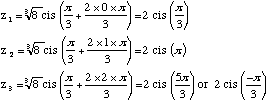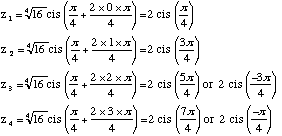|
Consider the rule for multiplying complex numbers in polar form
Squaring Complex NumbersSuppose that the two numbers are equal. i.e. z 1 = z 2 Then z2 = r cis θ. r cis θ = r2cis(θ + θ)
Cubing Complex NumbersLet z1 = r cis θ and z2 = r cis(2θ) Then z3 = r cisθ. r cis(2θ) = r cis(θ + 2θ)
De Moivre's TheoremThe above two derivations can be extended into a general rule known as De Moivre's Theorem:
Example Find (3 cis
Equations involving Complex Numbers The aim of this section is to solve equation of the type zn = r cis θ Taking the nth root of both sides z = (r cis θ)1/n By De Moivre's Theorem This provides one of the roots but because complex numbers in polar form repeat every 360° or 2π radians there will be other roots as well. The full solution set of the nth roots of r cis θ is given by: This will mean that when finding the nth root there will be n solutions. Example 1
Note that the three roots are equally spaced around a circle of radius 2 (cube root of 8) on the Argand diagram. This is true for all equations of the form zn = r cis θ. Once one root has been found the other roots can be placed, equally spaced, around a circle of radius the n th root of r. Example 2
|



